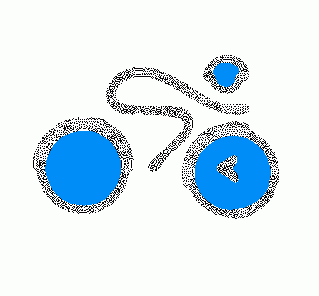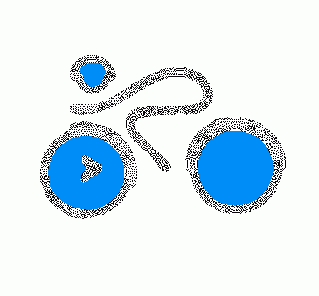| Newsletter - 2001 Archive |

|

|
Cycling Club |

|

|
| Newsletter - 2001 Archive |

|

|
Cycling Club |

|

|
Next--->
I've been asked this question, maybe not in exactly these words, quite a few times over the past four years while my name has appeared as information contact person in our club schedule/brochure, and I must say I haven't been able to defend our policy with much conviction. I usually say that the time limits are for the practical management of controls so that volunteers aren't forced to stay at remote locations for longer than they have to. And then typically I offer these words of assurance: "It's unlikely that you or I will be outside the time envelope no matter how fast or slow we are riding."
As time goes on I'm finding my own words on this subject increasingly problematic, and at odds with the way I feel. I've been wondering lately if our time limits aren't an anachronism, and whether there is any justification, practical or otherwise, for them except that they've always been there. It's interesting to note that there is no fast end limit for the '80 hour' group at PBP. I'm wondering now about the limit at the other end of the speed spectrum too, and what we are trying to accomplish through it. I think it's time to take a closer look at both the fast-end and slow-end time limits and how they are shaping randonneur cycling.
At the core of the sport of randonneur cycling is the notion that we are testing our limits. We stretch ourselves while striving to achieve various goals in a difficult activity frequently under difficult conditions. This sport is not for everyone. Our goals are often very personal, and are often related to our finishing time. What happens when a rider who is doing exactly the same activity as the rest of us, and who has the same sorts of goals, is excluded from the sport, for no reason other than the fact that rider is different from you and me? What justification is there for excluding that rider?
The difference I am talking about is of course a rider's cycling speed, and I think you can probably guess my next point: I don't think that people should be excluded from the sport of randonneur cycling on the basis of their cycling speed.
It goes without saying that cyclists come in all speeds. In our sport, 'going the distance' is the name of the game - a common goal we all share. The exertion required merely to finish will naturally vary wildly. A rider pushing hard at the slow end of the time envelope may be making a greater effort, and indeed showing more determination and courage, than a stronger cyclist in cruise mode riding many hours up the road. This is OK...people are different, and both riders should have the freedom to choose their effort level. In the end, both riders have an equal claim on the accomplishment of finishing the brevet, and they both have the same pin in that little glass jar on top of their dressers. Great. But what if that determined slow rider finishes outside the time limit? Are we really saying that this rider is not worthy? If forced to make a choice, I frankly would tempted to value the determination of the slow rider over the casually-employed, natural athletic gifts of the faster rider. The fact that we are excluding the slower rider altogether is, I feel, a serious concern.
Our absolute time limits are a means of discriminating against cyclists on the basis of speed. And it's a discrimination that indirectly runs deeper - our age, sex, whether we have a disability, and even whether we can afford a fast bike, are all factors affecting our cycling speed. We don't have to look very hard to see how this problem has been addressed elsewhere...
Marathon running is a sport in which people test their limits. They stretch themselves while striving to achieve various goals in a difficult activity frequently under difficult conditions. This sport is not for everyone. Their goals are often very personal, and are often related to their finishing time. In 1978 my mother was coerced into running the Toronto Marathon. I was surprised to learn from her recently how restrictive the time limit was in those days - 4½ hours. By 1986 when my wife ran Toronto the limit had been stretched to 5 hours, and the limit has been relaxed since then as well - the roads now close to participants moving slower that a 12 minute miles pace (the roads...but not the sidewalks.) The Toronto Marathon, now called the Canadian International Marathon, is actually unique among marathon running events today in that it warns "No Walkers Allowed" in order to discourage prospective slow finishers from entering, and clogging up the roadways. (Keeping the streets clean has always been important in To!) Nevertheless, even in Toronto, finishers coming in at 7 hours and beyond last year were listed as official finishers on the web site, and all were awarded finisher's medals.
Upping the ante one step further... As you might expect, the Boston Marathon (where participants must have exceptional qualifying times to even apply to enter) is strict about its time limit. Yet even here, at the most prestigious and competition-minded mass marathon in the world, the time limit stands at 6 hours - a slow jog. In fact in most large-city 'people's marathons' the limits have been discarded and the events are virtually open ended - at a certain point the route is reopened to vehicle traffic, but armies of slow joggers and walkers finish on the sidewalks. At the end of the day (and in some marathons, often it is the end of the day) these walkers, these shufflers, these 'penguins' all wear the same finisher's medal as the fast and medium paced runners who finish hours earlier.
There has been a healthy worldwide trend towards the democratization of the sport of distance running, a reflection of the fact that runners are not all created equal, but that they still may want to do the same activity. The enviable result of this change in attitude has been that many more people have become runners, and the notion that the races are for high performance athletes only is gone forever. Some factions within the endurance-running establishment have resisted these changes, but these voices have been drowned out. It's been a case of power to the people, and I think this is a revolution which most of us can celebrate.
It is also worth pointing out that in the sport of marathon and ultra marathon running, high performance athletes are also not excluded. It would be absurd to suggest that people in a marathon were not permitted to go as fast as they wish and that they face disqualification for getting to the finish too soon. In randonneur cycling this absurdity is a reality.
It's true that most cyclists would never find themselves up against the existing fast time limit unless riding on a particularly easy course - an extremely flat course, let's say. Well of course we have one of those particularly easy, extremely fast courses here in British Columbia, and for the past couple of years randonneurs have been showing up at the Country Market control near Rosedale, on the Fall Flatlander 200, well ahead of the control's opening time. Even riders in no particular hurry have found themselves standing around, munching cookies, and trying to get a handle on this whole time limit rule thing. Last year there were five of us standing around (though not at the same time because of a staggered start time for the benefit of the sign-in volunteers) tapping our cleats at Rosedale, and two more riders who arrived at the control shortly after its 'opening time'. A full 14% of participants (5 out of 36) were well ahead of the limit (19% if you count those two riders coming in.) I might add that the usual Lower Mainland speedsters, Ted and Keith, were not even riding that day and so were not in this advance party - the offending group was comprised of admittedly quick, but not necessarily elite cyclists. This tells me that we have a problem.
When I suggested recently to the BC Randonneur committee that this was a problem, my concerns were dismissed pretty absolutely. In a nutshell, here was the response: "If those guys want to go so fast, why don't they buy themselves racing licenses!" And also: "Keith Fraser regulates [slows] his pace so that he comes into the controls as the controls open". As for this latter point, our time limit rule is simply forcing a square peg into a round hole - why shouldn't Keith be allowed to go his pace? The former quip, however, about the racing licenses, gets more the core of our sport's discrimination against, and indeed curious contempt for, fast cyclists. And of course this attitude is a self-regenerating one because the rules we have established already exclude very fast and very slow riders. We have become an autocracy of medium paced cyclists - naturally there's no one around the table to speak for the people we have chosen to exclude.
The thing about fast cyclists is that they are like slow cyclists: they can't help how fast they are capable of riding. In randonneur cycling, we status quo medium paced cyclists can go as fast as we want - we are free to strive for our personal bests, to test our personal boundaries, and the limits of our endurance. Why don't we allow fast cyclists to do the same?
Here's an argument I'm sure some of you have heard: "The removal of the fast limit would encourage racing and there would be dangerous risk taking at the front of the pack." I've never bought this rationalization. I've seen appalling risk taking and dangerous cycling practices in the middle of the pack, and Keith and Ted and Ken are actually extremely disciplined and relatively cautious cyclists.
I suggest that speed has nothing to do with safe cycling practices. If safety is our concern, my feeling is that the two closely linked rules we need to cling to are these: randonneur cycling should remain resolutely amateur so that there's nothing at stake in 'winning', and secondly, the first rider to finish should continue to be considered the 'first finisher' - the first among equals - and not 'the winner', and should receive no special demarcation (trophies, prizes, etc.) Keith Fraser's pin jar looks a lot like yours and mine, and this is as it should be.
Fast cyclists determined to break the sound barrier should be free to do so. My guess is that they would not resort to dangerous racing tactics (...solo break aways launched at a red lights...) because working together with other similar paced, like-minded cyclists, would give them what they are really after - higher speeds and faster times. My prediction is that if the fast end time limit were thrown away, from a safety standpoint, nothing would change.
I certainly can't think of a compelling argument for keeping the limits that we have institutionalized, but I'm wondering if there isn't at least a historical explanation for them. Imagine for a moment that the existing time limits were even more restrictive, dramatically restrictive - where participants all had to ride at virtually the same pace. I think that with these rules in mind, groups of cyclists of roughly equal cycling strength would naturally band together and would probably designate one rider as a pacesetter. This person would be in charge of ensuring that the group stayed within the limits - no rider would be permitted to go ahead of the pace setter, and no rider would be allowed to drop off the back. Sound familiar? Yes, this is audax style cycling. (Hence the labelling of our key international institutions: Audax Club Parisien, Audax UK, Audax Australia, etc...)
Actually, I have only very limited knowledge of audax style cycling, so I might not have all of the above details correct. I will concede that it sounds appealing enough - an endearing and sociable 'gentlemen's sport'. I'm wondering, however, if it really has any relevance to the sport of randonneur cycling as it has evolved and whether lingering sentiments about it should continue to be a factor in the configuration of the contemporary rulebook. I might add that the opportunity to practice audax cycling within a brevet would in no way be adversely affected by throwing away the time limits. Indeed, very fast and very slow riders would suddenly be able to engage in audax style cycling, and on their own terms.
In concrete terms what am I suggesting? I'm saying we should eliminate the time limit for fast cyclists, because it serves no purpose. Ride organizers can still predict when control monitors need to be at their posts because there is a natural limit to how fast even the fastest cyclist can get from point A to point B.
On the slow end there may still be a practical limit to how long we want to burden a ride organizer with concerns of riders' safety out on the course, especially on longer brevets. And how far can the time confines of a ride be stretched and still satisfy even a very relaxed definition of what constitutes a distinct ride? Could we, for example, allow a participant a week, or a year to finish a 200? No, I'm not suggesting this. We would still need to draw a line, but let's craft one for practical reasons (fairness to ride organizers, and the actual speed of very very slow cyclists) and not our present exclusionary ones.
So where do we draw the line? Well, there is an obvious option, one which would make the limit crystal clear to riders and brevet organizers alike, and at all times on the course... Base the slow-end limit on 10 km/hour - no calculations necessary ever, and look at the beautiful symmetry:
200 km: 20 hours
300 km: 30 hours
400 km: 40 hours
600 km: 60 hours
1000 km: 100 hours
1200 km: 120 hours
It would be nice to eliminate the slow-end time limit completely for controls, making the finishing time the only time that matters...nice, but impractical. Control monitors need to know when they are free to leave. The controls could all be at 24-hour convenience stores, I suppose, but there would still be the matter of secret controls - there has to be a finite limit on the time a secret control monitor must stick around. So for practical reasons, control time limits will always be necessary, but of course there is no reason why the same relaxed 10 km an hour rule could not apply here too.
Change takes time, and this is not necessarily a bad thing. We can't expect Audax Club Parisien in France to reverse a century of tradition and adopt a change like this overnight. I don't expect BC Randonneurs to adopt this overnight either...but let me dream a little. Here's a thought: we could, as a club, recognize the completion of brevets outside the existing time envelope, and concede that for the time being these particular brevet results will not be forwarded to France. If we were to make the first step, I'm confident that changes which are so obviously good for the sport, would, in time, receive due consideration in France.
So I guess I'm proposing what might seem to some like a dramatic departure from the status quo - throwing our door open to both fast and slow cyclists. Truly though, I don't think we need fear either group - they won't ruin our sport. My suspicion is that they will enrich us with greater diversity, and I think we should welcome them all.
_